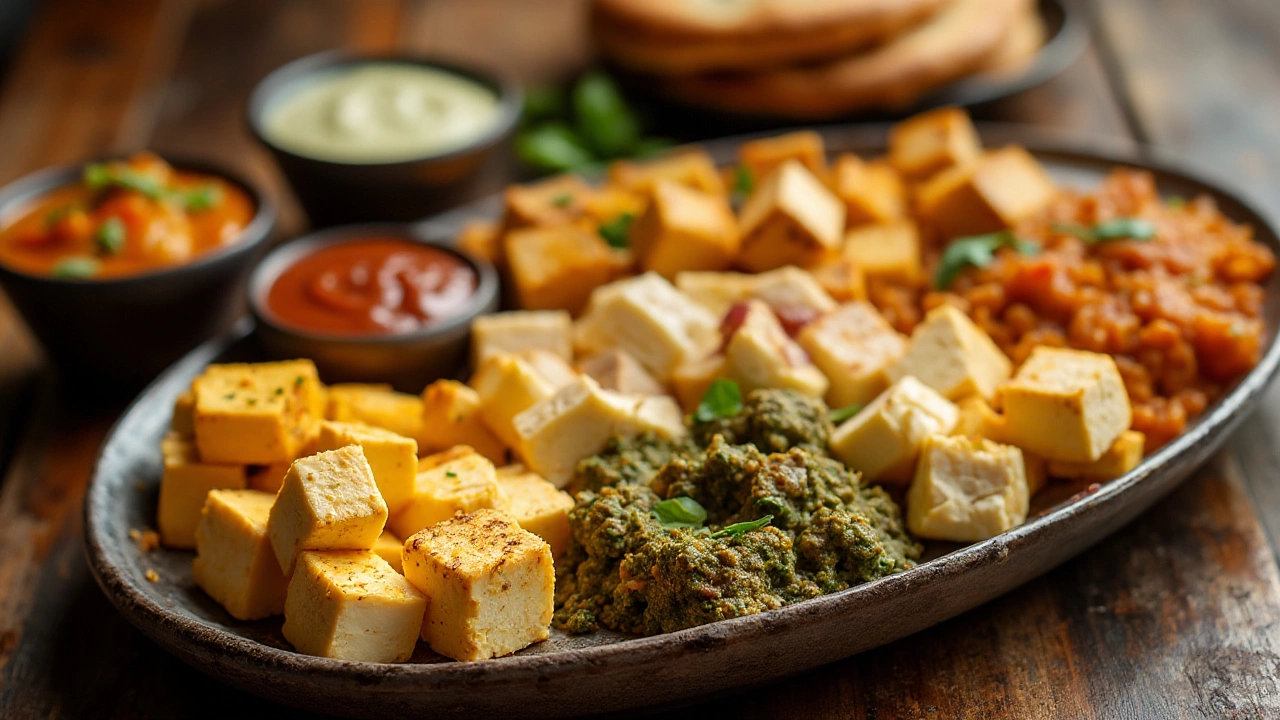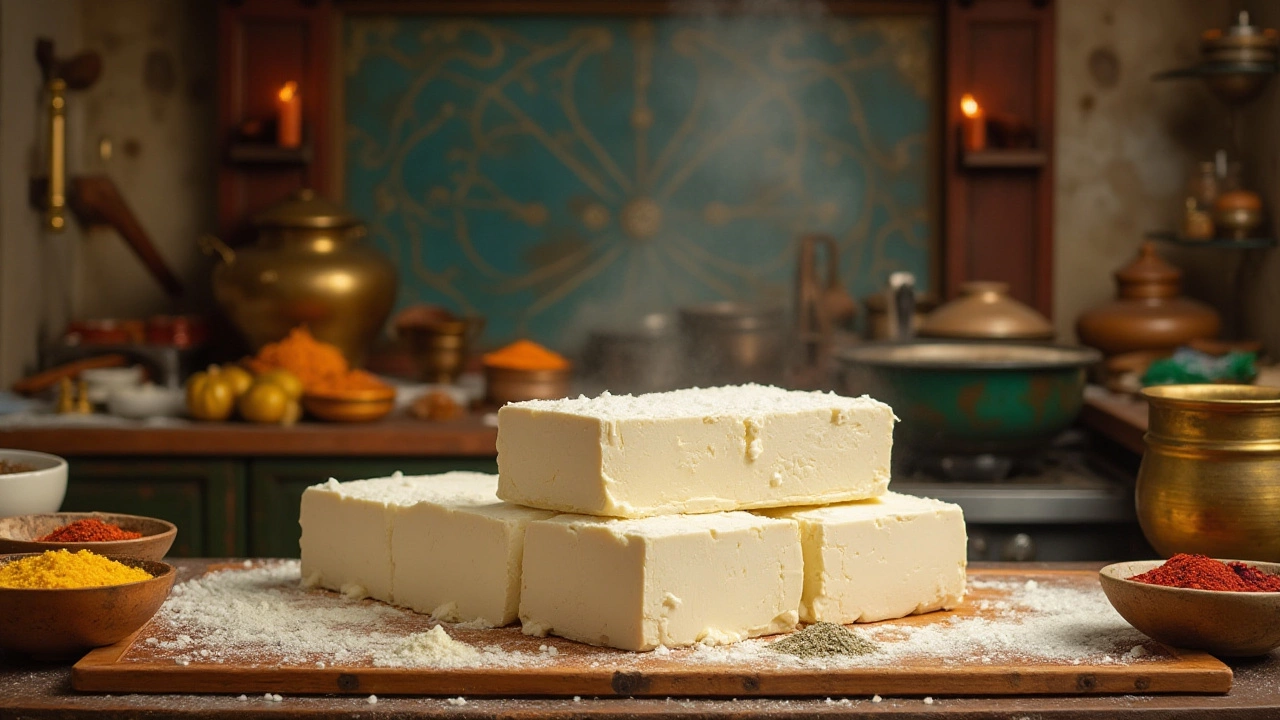30 Dec 2024
- 0 Comments
In many households, paneer is a beloved staple, known for its rich taste and firm texture. For those who savor this delightful dairy product, it can be a tempting addition to every meal. But before you herald paneer as your daily go-to, consider the potential drawbacks of such routine indulgence.
The creamy richness of paneer might mask some vital nutritional facts that deserve attention. From the calorie load hiding behind its soft, white facade to the saturated fats that might add more than just taste, these are aspects one should think about. Such enlightenment could catalyze a change in habitual consumption patterns, promoting a healthier approach to enjoying this cheese.
As we delve into these considerations, this article aims to offer insight into the savory little blocks that bring joy to many meals, balancing indulgence with health consciousness. Discover how daily paneer can affect your dietary health and explore alternatives to keep your wellness goals aligned.
- Introduction to Paneer and Its Popularity
- Nutritional Breakdown of Paneer
- Impact of Daily Paneer Consumption on Caloric Intake
- Health Concerns: Saturated Fat and Cholesterol
- Digestive Issues Related to Paneer
- Tips for Balanced Paneer Consumption
Introduction to Paneer and Its Popularity
Paneer, a quintessential component of Indian cuisine, has carved out a niche in culinary traditions worldwide, adored for its rich flavor and adaptable nature. This unaged, non-melting cheese originates from the Indian subcontinent, where it has enjoyed a lengthy legacy dating back hundreds of years. Traditionally made by curdling milk with a fruit or vegetable-derived acid, paneer provides a satisfying, approachable path into the vast landscape of cheese-making. Combining simplicity with versatility, this dairy delight can easily be incorporated into an array of dishes, from classic Indian curries to modern fusion recipes.
Consuming paneer daily is more than just a dietary choice for many; it is a cultural staple woven into the daily fabric of life across several regions. In fact, as noted by culinary historian, Colleen Taylor Sen, in her book "Feasts and Fasts: A History of Food in India," paneer's introduction to Indian cuisine can be traced back to the Afghan and Persian influences, making it a testament to India's rich history of cross-cultural exchanges. Across the globe, people have embraced its mild taste and delightful texture. Whether it's part of a traditional dish like Saag Paneer or enjoyed grilled as a standalone delight, paneer provides a protein-rich option perfect for vegetarians and omnivores alike.
Its popularity is not without reason. The nutritional benefits of paneer are significant, offering a hearty dose of protein, calcium, and essential fats. For vegetarians who might struggle to meet protein requirements, paneer provides a delectable solution that marries taste with nutrition. Yet, with fame comes inevitable scrutiny; as paneer consumption spreads beyond the Indian subcontinent, curious eyes examine its benefits and drawbacks. This cheese, cherished by many, stands as a reminder of the complex relationships we have with food—where culture, health, and pleasure intersect. Its rise in global cuisine is a testament to not only its flavor but its intriguing versatility.
Esteemed chef and Indian cuisine ambassador Madhur Jaffrey shares,
"Paneer is like a blank canvas; it takes on the colors and tastes you imbue in it."Indeed, this characteristic is what makes paneer an exceptional ingredient; its ability to absorb flavors ensures it never tires the palate, opening doors to endless creative possibilities in the kitchen. Such a universal appeal extends beyond traditional dishes, with contemporary chefs incorporating paneer into salads, wraps, and even desserts, thus reinforcing its position as a modern marvel.
Yet, while the appreciation of paneer is unapologetically joyous, discerning consumers must be informed. As we navigate through its savory allure, understanding how daily consumption affects our bodies becomes imperative. The culinary fame of paneer, while truly deserving, is balanced by a need for awareness about potential dietary impacts. Equipped with knowledge, one can relish in paneer’s creamy texture and comforting taste while remaining vigilant about health.
Nutritional Breakdown of Paneer
The exquisite flavor of paneer is undeniably a major part of its allure, but to understand its nutritional value, one must look beyond its taste. Composition-wise, paneer is primarily made from milk, thus inheriting a plethora of dairy benefits. One hundred grams of paneer generally contains about 20 grams of protein, making it a potent source of this vital macronutrient, especially for vegetarians who often look for plant-based protein sources. This level of protein intake supports muscle growth, tissue repair, and the synthesis of hormones, promoting overall health and vitality in those who consume it.
Beyond protein, paneer also offers a variety of vitamins and minerals. It is rich in calcium, essential for maintaining strong bones and dental health, and contains phosphorus, selenium, and magnesium. Vitamin A and Vitamin B12 also make an appearance, aiding in vision health and improving red blood cell formation, respectively. On the flip side, those who consume paneer daily should be cautious of its calorie contribution, usually ranging around 265 calories per 100 grams. This might be a significant portion of one's daily caloric intake, potentially leading to weight gain if not monitored properly.
One cannot overlook the fat content of this dairy delight. Paneer contains high levels of saturated fats, approximately 20 grams per 100 grams, which can have implications for heart health if consumed in excessive amounts. This highlights the necessity for moderation, particularly for individuals prone to heart disease. Still, it’s worth noting how paneer's fats are not entirely detrimental; they help in the absorption of fat-soluble vitamins like A, D, E, and K. Integrating paneer into a balanced diet can provide these benefits while minimizing risks.
Interestingly, some nutritionists suggest that the fermentation process during the making of homemade paneer can enhance its probiotic qualities. In an article from the Journal of Food Science, it was noted, "The fermentation process in paneer production may boost intestinal health, offering an edge to homemade varieties." Such probiotics play a role in maintaining a healthy gut flora, which is pivotal for digestive health and immunity.
To truly grasp the nutritional profile of paneer, one should also consider its role in traditional culinary scenes, where it often partners with ingredients like spices, vegetables, and grains to not only enhance taste but also increase the overall nutrient density of a meal. This practice not only diversifies macronutrient intake but also balances the mineral and vitamin proportions, showcasing how paneer can be enjoyed in various dimensions both healthily and effectively.

Impact of Daily Paneer Consumption on Caloric Intake
Paneer is a delightful indulgence, appealing to many with its rich flavor and creamy texture. However, consuming paneer daily can quietly escalate your caloric intake without you even realizing it. A standard serving of paneer, about 100 grams, packs around 265 calories, which largely stem from its fat and protein content. Though these nutrients are vital, the caloric density of paneer can contribute significant calories to the diet, especially if included in every meal. Considering the daily recommended caloric intake for an average adult ranges between 2000-2500 calories, it's easy to see how a constant presence of paneer could tip you over the edge, particularly if paired with other calorie-dense foods.
Interestingly, homemade paneer can sometimes carry even more calories than store-bought options because of the full-fat milk often used in its preparation. Many traditional recipes don’t shy away from full-fat options to achieve maximum creaminess and flavor. Regular intake means these calories accumulate day after day, potentially leading to unwanted weight gain if not balanced with exercise or other lower-calorie food choices. It’s essential to be aware of how these cumulative choices affect your daily caloric balance. Michael Pollan, a respected food journalist, mentions, "Eat food, not too much, mostly plants." This serves as a reminder to balance rich foods like paneer with an abundant variety of fruits, vegetables, and other low-calorie plant-based options.
For those who adore paneer but wish to manage their caloric intake, moderation is key. Incorporating paneer into meals as a seasoning rather than the centerpiece might be an effective strategy. Consider blending small cubes into salads or as toppings rather than an entire paneer curry dish. This allows you to relish its taste while avoiding a calorie overload. Another useful trick is to prepare low-fat paneer by skimming the cream off the milk before curdling it, thus reducing its caloric load significantly without sacrificing the homemade taste. Deliberate and mindful adjustments like these can enable you to enjoy paneer’s delightful creaminess without jeopardizing caloric goals.
Health Concerns: Saturated Fat and Cholesterol
Peneer, as delightful as it is in its creamy simplicity, comes with its own set of nutritional footprints. For those unversed in dietary science, it might just be another accusation against a usually innocuous dairy product. But, in fact, paneer contains a significant proportion of saturated fat, which warrants a closer look. Saturated fats are known to impact heart health negatively by raising low-density lipoprotein (LDL) cholesterol levels in the blood. This kind of cholesterol, often dubbed as 'bad cholesterol', can lead to the development of heart disease if consumed in excessive amounts over time. Thus, daily indulgence in paneer could surreptitiously tilt the scales against your cardiovascular health.
It's important to understand how much saturated fat is present in the paneer you consume. Typically, a 100-gram serving of homemade paneer can contain up to 20 grams of fat, with more than half coming from saturated fats. This means that if one isn't careful, such a small delight can quickly escalate one's daily saturated fat intake far beyond recommended levels. The American Heart Association suggests that only 5 to 6 percent of your total daily calories should come from saturated fats, translating to about 13 grams per day in a 2,000-calorie diet. With paneer, reaching and exceeding this recommended limit is deceptively easy.
"A high intake of saturated fats is a key risk factor for cardiovascular diseases," notes the Harvard T.H. Chan School of Public Health.
It’s often advised to replace saturated fats with healthier fats, such as those found in nuts, seeds, and fish, to mitigate the overall impact on cholesterol levels. For paneer lovers, transitioning to lower-fat versions or incorporating more plant-based proteins into their diet can be a healthier alternative without forgoing the delight entirely. Balancing your diet with fiber-rich foods like vegetables and whole grains can also help manage cholesterol levels effectively. Reducing the dependency on full-fat dairy options by intermittently substituting with these alternatives can keep the taste variety on your palate while also guarding your heart health.
Pursuing moderation is key. Simply put, while paneer is a beloved staple in many households, its regular, unchecked consumption can lead to unintended health consequences. To keep your heart happy and healthy, it’s worth evaluating and adjusting your paneer intake, ensuring your dietary practices always prioritize long-term wellness over short-term pleasure.

Digestive Issues Related to Paneer
Paneer, known for its wonderfully creamy texture and firm bite, is truly a culinary delight. Yet, indulging in it daily may give rise to a few unexpected digestive woes. Paneer, largely composed of milk, contains lactose, which can be a hurdle for those with lactose intolerance. This condition, affecting countless individuals worldwide, causes an inability to properly digest lactose due to a deficiency in the enzyme lactase. This makes paneer a not-so-friendly option for some guts, potentially leading to bloating, cramps, and other forms of gastric discomfort.
In addition to lactose, let's not forget casein, a primary protein found in homemade paneer. While it is an excellent source of protein, casein is known to be slow-digesting, which isn't ideal for everyone. For those with casein sensitivity or allergy, consumption of paneer might provoke adverse reactions ranging from mild stomach distress to severe digestive challenges. This slow digestion process of casein can contribute to prolonged feelings of heaviness or sluggishness, especially if consumed in large quantities regularly.
Moreover, some people might discover their digestive systems aren't entirely fond of the rich, fatty nature of dairy products like paneer. High intake of saturated fats can take a toll on one's gastrointestinal well-being, leading to irregular bowel movements or constipation. An interesting study published in the 'Journal of Food Science' highlights that fermentation of dietary fats in the gut can sometimes produce byproducts that influence bowel movement patterns.
Incorporating paneer into one's daily diet without moderation can also place a strain on the gut's microbiota balance. Our gut contains a universe of bacteria, both beneficial and potentially harmful. A shift toward more fat-rich foods can alter this delicate balance, potentially leading to digestive discomfort. For those dedicated to maintaining their digestive health, being mindful of how much paneer they consume and balancing it with fiber-rich foods can play a crucial role in achieving harmony.
"Increased dairy intake has drastic effects on the gut microbiome, potentially leading to digestive discomfort among specific populations," shared Dr. Williams in his recent publication.
For those who enjoy paneer as part of their meals, it is wise to listen closely to their body's signals. Excessive daily consumption might not be suitable for everyone. To savor paneer while nurturing good digestive health, it is important to incorporate a variety of foods. Opt for plenty of vegetables, whole grains, and other fiber-rich food items to encourage smoother digestion and a well-balanced diet.
Tips for Balanced Paneer Consumption
When it comes to including paneer in your diet, balance and mindfulness are key to ensuring that you enjoy all its flavors and benefits without the downside of daily indulgence. First and foremost, portion control is crucial. Many people, lured by its comforting taste, tend to overconsume paneer, which can inadvertently lead to a spike in calorie intake. By keeping servings around 100 grams per meal, you can savor the creamy texture and flavor without going overboard.
Pairing homemade paneer with an abundance of vegetables can be another effective strategy. Vegetables like bell peppers, spinach, and tomatoes not only complement the taste of paneer but also add vital nutrients and fiber to your diet. This helps in digesting the dairy component more efficiently, making for a nutrient-balanced meal that's satisfying yet healthy. In addition, switching up the preparation methods can also contribute to healthier consumption. Grilling or sautéing paneer with little to no oil instead of deep-frying it significantly reduces the intake of unwanted fats.
For those who are concerned about the saturated fats and cholesterol associated with regular paneer consumption, opting for alternatives like tofu or low-fat versions of paneer might be beneficial. These substitutes mimic the texture and versatility of paneer while presenting a lighter profile on the body. Incorporating such alternatives a few days a week can keep meals interesting and health-conscious. A 2022 study in the Journal of Nutrition found that diet variations, including the introduction of plant-based proteins, can effectively lower LDL cholesterol levels.
Spreading the consumption throughout the week rather than focusing it on a few days can prevent the body from facing a shock of excess dairy on certain days. This approach keeps your diet varied and your meals exciting. As a tip, decide a specific day to indulge in paneer-centric dishes like paneer curry or paneer tikka; this makes these treats even more special.
"Moderation in everything—even moderation," said the Roman playwright Petronius. This age-old wisdom resonates well when it comes to enjoying indulgent foods like paneer.
- Limit the portion size of paneer to 100g per meal.
- Integrate a variety of vegetables for increased fiber.
- Opt for grilling or sautéing instead of frying.
- Use plant-based alternatives like tofu to reduce fat intake.
- Plan meals that spread out paneer intake through the week.
Personal meal planning with these tips in mind can not only reduce the potential downsides of daily paneer consumption but also make for a more enjoyable and health-conscious dining experience. It’s important to listen to your body and make choices that feel good both mentally and physically, and these adjustments can guide you toward a sustainable approach to eating this beloved cheese.
